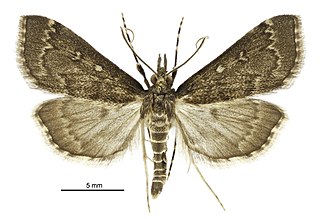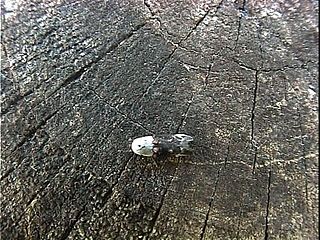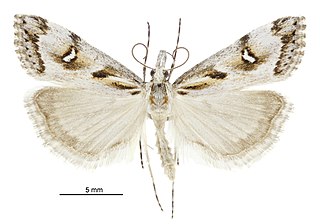
Proternia is a monotypic moth genus of the family Crambidae described by Edward Meyrick in 1884. Its only species, Proternia philocapna, described by the same author in the same year, is endemic to New Zealand.

Trachypepla euryleucota is a species of moth in the family Oecophoridae. It is endemic to New Zealand and can be found throughout the country. They inhabit native forest and the larvae are leaf litter feeders and have also been found feeding on and in bird nests. Adults are on the wing from December to March, are nocturnal and are attracted to light. During the daylight hours they can be sometimes be observed resting on walls or fences. It has been hypothesised that the adults resemble an opening manuka flower bud or bird droppings in order to camouflage themselves from predators. The raised tufts on their forewings possibly also assist with camouflaging this moth when they rest on lichen.
Heterocrossa epomiana is a species moth in the family Carposinidae. It is endemic to New Zealand.

Heterocrossa gonosemana is a species of moth in the family Carposinidae. It is endemic to New Zealand.
Leptozestis oxyptera is a moth in the family Cosmopterigidae described by Oswald Bertram Lower in 1900. It is found in Australia, where it has been recorded from New South Wales.

Gadira leucophthalma, commonly known as the beaked moss moth, is a moth in the family Crambidae. It is endemic to New Zealand. It is found in the south eastern side of the South Island down to Banks Peninsula. G. leucophthalma inhabits the foredunes of coastal areas. The larval host is unknown but it has been hypothesised that the larvae feed on moss. The adult moths are day flying although some specimens have been trapped at night via light traps. Adults are commonly on the wing from March to April. This species has been classified as Nationally Vulnerable by the Department of Conservation.
Scoparia epigypsa is a moth in the family Crambidae. It was described by Oswald Bertram Lower in 1902. It is found in Australia, where it has been recorded from New South Wales.
Scoparia leuconota is a moth in the family Crambidae. It was described by Oswald Bertram Lower in 1902. It is found in Australia, where it has been recorded from South Australia.

Scoparia paracycla is a moth in the family Crambidae. It was described by Oswald Bertram Lower in 1902. It is found in Australia, where it has been recorded from New South Wales and Queensland.
Scoparia stenopa is a moth in the family Crambidae. It was described by Oswald Bertram Lower in 1902. It is found in Australia, where it has been recorded from South Australia.
Glyphodes mesozona is a moth in the family Crambidae. It was described by Oswald Bertram Lower in 1901. It is found in Australia, where it has been recorded from Queensland.
Metasia strangalota is a moth in the family Crambidae. It was described by Edward Meyrick in 1887. It is found in Australia, where it has been recorded from New South Wales.

Nacoleia mesochlora is a moth in the family Crambidae. It was described by Edward Meyrick in 1884. It is found in Australia, where it has been recorded from Queensland, the Northern Territory, New South Wales, Victoria, South Australia and Western Australia.

Sufetula hemiophthalma is a moth in the family Crambidae. It was described by Edward Meyrick in 1884. It is found on the Cook Islands, French Polynesia, Fiji and Australia, where it has been recorded from New South Wales and Queensland.
Homadaula coscinopa is a moth in the family Galacticidae. It was described by Oswald Bertram Lower in 1900. It is found in Australia, where it has been recorded from New South Wales.
Ardozyga deltodes is a species of moth in the family Gelechiidae. It was described by Oswald Bertram Lower in 1896. It is found in Australia, where it has been recorded from Victoria and New South Wales.
Ardozyga desmatra is a species of moth in the family Gelechiidae. It was described by Oswald Bertram Lower in 1897. It is found in Australia, where it has been recorded from New South Wales, Victoria and South Australia.
Ardozyga thanatodes is a species of moth in the family Gelechiidae. It was described by Oswald Bertram Lower in 1893. It is found in Australia, where it has been recorded from South Australia.
Ardozyga tridecta is a species of moth in the family Gelechiidae. It was described by Oswald Bertram Lower in 1900. It is found in Australia, where it has been recorded from South Australia.
Tanycnema is a monotypic moth genus of the family Tineodidae or false plume moths. It was described by Alfred Jefferis Turner in 1922. Turner described the genus in Proceedings of the Royal Society of Victoria, writing:
Gen. Tanycnema, nov.
Frons with a strong anterior tuft of hairs. Tongue present. Palpi rather long, porrect. Maxillary palpi obsolete. Antennae short. Legs long, slender; outer tibial spurs about 3/4 length of inner spurs. Forewings narrow, elongate; 2 from well before angle, 3 from angle, 4 and 5 somewhat approximate at origin, 6 from upper angle, 7, 8, 9, 10 stalked, 7 arising slightly before 10, 11 free. Hindwings twice as broad as forewings; 2 from 3/4, 3 from angle, 4 and 5 somewhat approximate at origin, 6 well separated at origin from 5, still more widely from 7, 7 from upper angle, closely approximated to 12 for some distance, but not anastomosing.
A peculiar, isolated, and primitive genus. The wide separation of 6 from 7 of the hindwings, and the absence of any anastomosis of 7 with 12 are primitive characters; on the other hand the relative approximation of 5 to 4 in the hindwings, and the stalking of 7 and 10 of the forewings are specialised characters, the former being unique in this family, to which the genus must, I think, be referred, though the absence of maxillary palpi, suggests some relationship to the Pterophoridae, but this may be more apparent than real.






